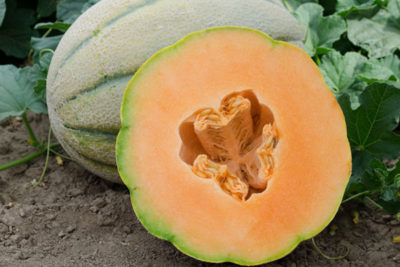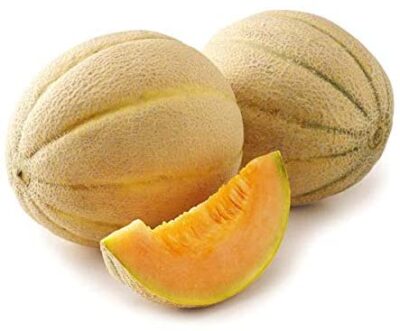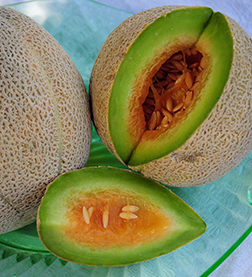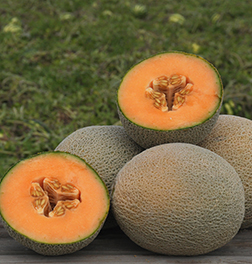Cantaloupe
Cantaloupe is the crop that Rocky Ford is famous for. Grown under ideal conditions, our cantaloupe seeds are some of the best to be found. Hot days, cool nights and timed drip irrigation produces sweeter melons.
Cantaloupe seeds may be planted directly in the ground when soil temperature reaches 65º and all danger of frost is past. Heavy feeders, they prefer a sandy loam amended with composted manure. In cooler climates, start seedlings inside, transplanting when putting out the rest of your warm weather crops. Planting in hills, 3′ apart in rows 5′ or 6′ apart is recommended. Seed should be planted at a 1″ depth. Water at the base of the plant or with irrigation every two weeks until melons reach softball size before allowing the plant to finish maturing without watering further. Drier soil at this stage improves sugar content. Cantaloupe are ripe when fruit pulls from the vine with no effort.
Good companion crops are radishes, nasturtium, catmint and dill. Bad companion crops are tomatoes, mustard, strawberries and beans.
-

Cantaloupe – Burrell’s Jumbo (Hale’s Best)
$2.60 – $20.10 -

Cantaloupe – Athena F1 Hybrid
$7.60 – $136.30 -

Cantaloupe – Primo F1 Hybrid
$5.40 – $60.70 -

Cantaloupe – Uvalde
$2.60 – $28.10 -

Cantaloupe – Goddess F1 Hybrid
$5.90 – $86.50 -

Cantaloupe – San Luis F1 Hybrid
$7.20 – $44.10 -

Cantaloupe – Pancho Grande F1 Hybrid
$5.80 – $71.10 -

Cantaloupe – Honey Rock
$2.60 – $39.10 -

Cantaloupe – Eden Gem (Rocky Ford Green)
$2.60 – $36.10 -

Cantaloupe – San Juan F1 Hybrid
$4.60 – $34.10 -

Cantaloupe – Topmark
$2.60 – $32.10 -

Cantaloupe – Hearts of Gold
$2.60 – $39.10 -

Cantaloupe – Dove F1
$7.70 – $135.50 -

Cantaloupe Ambrosia F1 Hybrid
$12.60 -

Cantaloupe – Holbrook F1 Hybrid
$5.80 – $71.70 -

Cantaloupe – Python F1 Hybrid
$4.95 – $63.70 -

Cantaloupe – Visa F1 Hybrid
$6.10 – $81.40
Growing Cantaloupes
Plant 2 lb. per acre in drills or 1 lb. if hand planted in hills 1 oz. to 100 hills. Plant 1 inch deep. The land should be sandy loam, avoiding both to sandy and too heavy soil. If possible, do not plant where cantaloupes were grown previously within three or four years. A heavy stubble plowed under is one of the first locations. Bean land is usually very good. The first year after alfalfa or clover is not good as a rule because the melons grow to soft and are irregular in size, shape, nettings and quality. The second year after alfalfa or clover is usually very good. Fall plowing is best, followed in the spring with several discing. If planted in hills the rows should be 5 to 6 feet apart each way. Cross cultivating improves the yield, quality and earliness. Plant ten to twelve seeds to the hill about 2 inches deep and thin to one or two plants when they have 5 or 6 leaves. Cantaloupe seed needs to have a minimum of at least 60 degrees Fahrenheit within the top 4 inches of soil to have a good germination. If drilled in rows 5 to 6 feet apart thin to one plant every 3 to 4 feet. Hoe carefully around the plants; keep free from weeds and cultivate often. We have found 8 or 10 cultivations at least should be giving and more would be better. After the vines reach so far across the row that you can no longer cultivate, the ends of the vines should be carefully turned back and an additional cultivation given. Cultivate shallow close to the plants and deeper farther away. Deep cultivation will cut the roots and damage the crop. The main spread of roots is on the harder ground under the plowed ground. For this reason plowing should be 8″-10″ deep and cultivation by knives or sweeps rather than shovels. If under irrigation, cantaloupes should be watered regularly about every two weeks. Early in the season furrows should be close to the plants and water should be allowed to run just long enough to moisten the soil beyond the plant row. Later furrows may be kept farther away from the plants. Do not allow the water to remain in the furrows to long so that the soil becomes waterlogged. Continue irrigating through the ripening season to keep the vines thrifty. Do not water after fruit reach softball size or larger as this can cause the fruit to rot. Adequate bee population is necessary for good pollination and fruit set. Our business has been closely associated with the cantaloupe industry. Since the first green-fleshed, Rocky Ford’s were shipped from our hometown, our catalog has carried the continued story of the improvement in varieties of shipping cantaloupes.
-

Cantaloupe – Dove F1
$7.70 – $135.50 -

Cantaloupe – Hearts of Gold
$2.60 – $39.10 -

Cantaloupe – Honey Rock
$2.60 – $39.10 -

Cantaloupe – Goddess F1 Hybrid
$5.90 – $86.50 -

Cantaloupe – San Juan F1 Hybrid
$4.60 – $34.10 -

Cantaloupe – San Luis F1 Hybrid
$7.20 – $44.10 -

Cantaloupe – Pancho Grande F1 Hybrid
$5.80 – $71.10 -

Cantaloupe – Primo F1 Hybrid
$5.40 – $60.70 -

Cantaloupe – Python F1 Hybrid
$4.95 – $63.70 -

Cantaloupe – Holbrook F1 Hybrid
$5.80 – $71.70 -

Cantaloupe – Athena F1 Hybrid
$7.60 – $136.30 -

Cantaloupe – Visa F1 Hybrid
$6.10 – $81.40 -

Cantaloupe Ambrosia F1 Hybrid
$12.60 -

Cantaloupe – Topmark
$2.60 – $32.10 -

Cantaloupe – Uvalde
$2.60 – $28.10 -

Cantaloupe – Eden Gem (Rocky Ford Green)
$2.60 – $36.10 -

Cantaloupe – Burrell’s Jumbo (Hale’s Best)
$2.60 – $20.10
Growing Cantaloupe.
Cantaloupe is the crop that Rocky Ford is famous for. Grown under ideal conditions, our cantaloupe seeds are some of the best to be found. Hot days, cool nights and timed drip irrigation produces sweeter melons.
Cantaloupe seeds may be planted directly in the ground when soil temperature reaches 65º and all danger of frost is past. Heavy feeders they prefer a sandy loam amended with composted manure. In cooler climates, start seedlings inside, transplanting when putting out the rest of your warm weather crops. Planting in hills, 3′ apart in rows 5′ or 6′ apart is recommended. Seed should be planted at a 1″ depth. water at the base of the plant or with irrigation every two weeks until melons reach softball size. Drier soil at this stage improves sugar content. Cantaloupe are ripe when fruit pulls from the vine with no effort.
Good companion crops are radishes, nasturtium, catmint and dill. Bad companion crops are tomatoes, mustard, strawberries and beans.


